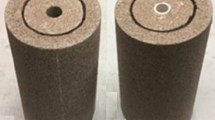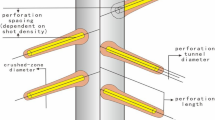Abstract
In the petroleum production industry wells are mostly cased and perforated in the producing formation. Perforation characteristics such as size, length, number of perforation tunnels and their arrangements as well as fluid and rock properties determine fluid flow behaviour in the wellbore region, hence, well productivity. Flow of gas and condensate around a perforation tunnel (including the damaged zone) has been studied by performing steady-state core experiments and simulating the results numerically, using a finite element modelling approach. The model allows for the changes in fluid properties and accounts for the coupling of the two phases and the inertial effect using a fractional flow based correlation. The results indicated that different sets of thickness-permeability (h−k) values obtained from matching single-phase flow performance could be assigned to the damaged zone around perforation to represent the two-phase flow performance. The status of the tip of the perforation for two extreme cases of totally closed and fully open was investigated and found to have a minimal effect on the performance of the system.
Similar content being viewed by others
References
Behie A. and Settari A. (1993) Perforation design models for heterogeneous, multiphase flow, SPE 25901, pp. 591–602, Proceedings of SPE RMR/Low Permeability Reservoir Symposium, Denver, Colorado, USA.
W.T. Bell E.F. Brieger J.W. Harrigan (1972) ArticleTitleLaboratory flow characteristics of gun perforations J. Petrol. Technol. 24 IssueID2 1095–1103
Brooks J.E. (1997) A simple method for estimating well productivity, SPE 38148, pp. 57–64, Proceedings of SPE EFDC, The Hague, The Netherlands.
H.L. Chen S.D. Wilson T.G. Monger-McClure (1997) ArticleTitleDetermination of relative permeability and recovery for North Sea gas-condensate reservoirs SPE Reservoir Evaluation & Engineering 2 IssueID4 393–402
A. Danesh M. Khazam G.M. Henderson D.H. Therani J.M. Peden (1994) Gas condensate recovery studies DTI Improve Oil Recovery and Research Dissemination Seminar London
Dogulu Y.S. (1998) Modelling of productivity in perforated completions, SPE 51048, pp. 109–117, Proceedings of SPE ERM, Pittsburgh, Pennsylvania, USA.
Egan F. (1984) A finite element analysis of steady-state darcy and non-Darcy oil flow towards perforated wells, M.Sc. Thesis, University College.
Femlab Multiphysics Reference Manuals by COMSOL Inc., June 2002, version 2.3.0.145.
P. Forchheimer (1914) Hydraulik Leipzig Berlin 116–118
J. Geertsma (1974) ArticleTitleEstimating the coefficient of inertial resistance in fluid flow through porous media SPEJ 14 445–450
M.H. Harris (1966) ArticleTitleThe effect of perforating on well productivity J. Petrol. Technol. 18 518–528
Henderson, G. D., Danesh, A., Tehrani, D. H., Peden, J. M.: 1996, Measurement and correlation of gas condensate relative permeability by the steady-state method, SPEJ, 191–201.
G.D. Henderson A. Danesh D.H. Tehrani (2001) ArticleTitleEffect of positive rate sensitivity and inertia on gas condensate relative permeability at high velocity Petrol. Geosci. 7 45–50
K.C. Hong (1975) ArticleTitleProductivity of perforated completions in formations with and without damage J. Petrol. Technol. 27 IssueID2 1027–1038
Ichara M.J. (1987) The performance of perforated completions in gas reservoirs, SPE 16384, Proceedings of SPE CRM, Ventura, California, USA, pp. 567–586
M. Jamiolahmady A. Danesh D.H. Tehrani D.B. Duncan (2000) ArticleTitleA mechanistic model of gas-condensate flow in pores Transport Porous Media 41 IssueID1 17–46 Occurrence Handle10.1023/A:1006645515791
M. Jamiolahmady A. Danesh D.H. Tehrani D.B. Duncan (2003) ArticleTitlePositive effect of flow velocity on gas-condensate relative permeability: network modelling and comparison with experimental results Transport Porous Media 52 IssueID2 159–183 Occurrence Handle10.1023/A:1023529300395
Jamiolahmady M., Danesh A., Henderson G.D., Tehrani D.H. (2003) Variations of Gas-Condensate Relative Permeability with Production Rate at Near Wellbore Conditions: A general Correlation, SPE 83960, Proc. SPE OEC, Aberdeen, UK
Jamiolahmady M., Danesh A., Sohrabi M., Duncan D.B. (2004) Flow around a rock perforation surrounded by damaged zone: Experiments vs. Theory, Submitted for publication to J. Petrol. Sci. Engng.
Jamiolahmady M., Danesh A., Duncan D.B. (July 2005) An improved understanding of positive velocity dependency of gas-condensate relative permeability: a mechanistic approach, in: Proceedings of 7th World Congress of Chemical Engineering, Glasgow, UK.
S. Locke (1981) ArticleTitleAn advanced method for predicting the productivity ratio of a perforated well. J. Petrol. Technol. 33 IssueID2 2481–2488
Matlab Reference Manuals by the MathWorks Inc., May 2003, version 6.5.
J.M. McDowell M. Muskat (1950) ArticleTitleThe effect on well productivity of formation beyond perforated casing Petroleum Transactions AIME 189 309–312
H.O. McLeod (1983) ArticleTitleThe effect of perforating conditions on well performance J. Petrol. Technol. 35 IssueID1 31–39
M. Muskat (1943) ArticleTitleThe effect of casing perforations on well productivity Petroleum Transactions AIME 151 175–187
B.H. Sage B.L. Hicks W.N. Lacey (1940) ArticleTitlePhase equilibria in hydrocarbon system- The Methane-n-Butane systems in the two-phase region Ind. Eng. Chem. 32 1058–1092
SUPERTRAPP (NIST Thermophysical Properties of Hydrocarbon Mixture Database) User’s Guide by National Institute of Standards and Technology (NIST), NIST Standard Reference Database 4, July 1992, version 1.0.
C.F. Weinaug D.L. Katz (1943) ArticleTitleSurface Tension of Methane-Propane Mixtures Industrial Engineering Chem 35 IssueID2 239–246
Saleh A.M., Stewart G. (1996) New approach towards understanding of near well bore behaviour of perforated completions, SPE 36866, pp. 447–464, Proceedings of SPE EPC, Milan, Italy.
S.M. Tariq (1987) ArticleTitleEvaluation of flow characteristics of perforations including non-linear effects with the finite element method SPE Prod. Engng. 2 104–112
Author information
Authors and Affiliations
Corresponding author
Rights and permissions
About this article
Cite this article
Jamiolahmady, M., Danesh, A., Sohrabi, M. et al. Measurement and Modelling of Gas Condensate Flow Around Rock Perforation. Transp Porous Med 63, 323–347 (2006). https://doi.org/10.1007/s11242-005-6870-0
Received:
Accepted:
Issue Date:
DOI: https://doi.org/10.1007/s11242-005-6870-0




